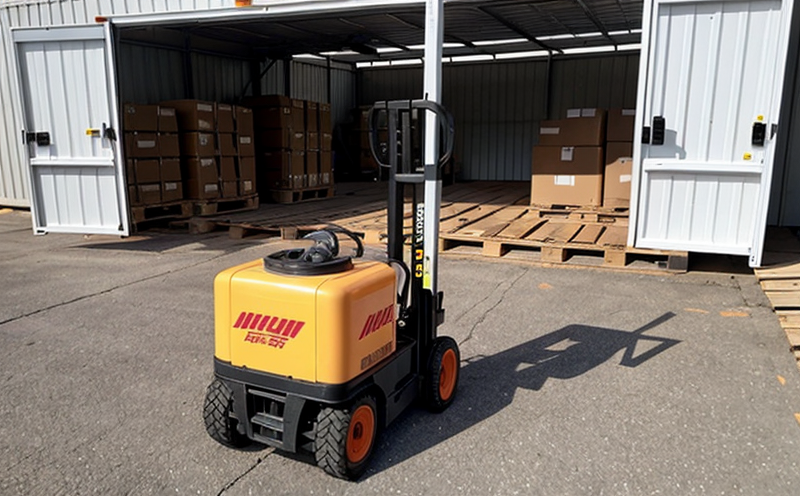Pallet Truck Safety Inspection
The pallet truck safety inspection is a critical process in ensuring the safe and efficient operation of industrial lifting equipment. Pallet trucks are essential tools in warehouse management, logistics, and manufacturing environments where they facilitate the movement of heavy loads with minimal physical strain on personnel. Ensuring these vehicles meet stringent safety standards not only enhances operational efficiency but also prevents accidents that could result in significant financial losses and potential injuries.
According to ISO 1036:2004, pallet trucks are designed for manual handling operations within industrial environments. These devices are characterized by their compact design, ease of maneuverability, and the ability to lift loads up to a maximum capacity specified on the product label. The safety inspection process involves a comprehensive evaluation of various components including the hydraulic system, braking mechanism, lifting mechanisms, and structural integrity.
The first step in any pallet truck safety inspection is visual inspection. This includes checking for visible signs of wear or damage such as cracks, rust, and loose bolts. It's crucial to examine all critical areas like the frame, wheels, and steering mechanism. Following this initial assessment, a functional test should be conducted to ensure that all components are working in harmony without any anomalies.
For hydraulic systems, testing involves observing pressure levels under load conditions and checking for leaks. Braking mechanisms must be tested by applying brakes while lifting the load to verify their effectiveness. Structural integrity tests involve loading the truck beyond its rated capacity to observe how it handles additional weight. Compliance with international standards such as ISO 1036:2004 ensures that these inspections meet industry best practices.
Regular safety checks are vital for maintaining optimal performance and extending the lifespan of pallet trucks. By incorporating proactive maintenance into daily operations, organizations can significantly reduce downtime and associated costs. This approach also contributes to creating safer working conditions by identifying potential hazards early on.
In conclusion, a thorough pallet truck safety inspection is essential for any organization operating in sectors reliant on manual material handling equipment. It provides peace of mind knowing that your workforce is using reliable tools while minimizing risks associated with improper usage or neglected maintenance practices.
Industry Applications
The pallet truck safety inspection finds extensive applications across various industries where efficient and safe material handling is paramount. In logistics and warehousing, the frequent movement of goods requires reliable lifting equipment capable of enduring harsh operating conditions. Warehouse managers rely on regular inspections to ensure that all pallet trucks comply with regulatory requirements and maintain peak operational performance.
Manufacturing facilities also benefit greatly from consistent pallet truck safety inspections due to their heavy reliance on industrial lifters during production processes. Ensuring these machines operate safely helps prevent costly downtime resulting from mechanical failures or accidents involving personnel. Additionally, retail environments where stock needs frequent restocking find value in conducting regular checks to guarantee smooth operations throughout peak periods.
The construction sector too appreciates the importance of pallet truck safety inspections given the need for robust equipment capable of withstanding challenging terrain and weather conditions. By prioritizing safety through routine maintenance practices, contractors can avoid delays caused by broken machinery or injuries sustained during manual lifting tasks.
Transportation companies further emphasize the necessity of maintaining safe working environments for their employees by adhering to strict inspection protocols before each shift begins. This ensures that all vehicles are roadworthy and capable of handling the demands placed upon them without compromising safety standards.
Quality and Reliability Assurance
The quality and reliability assurance processes associated with pallet truck safety inspections encompass several key aspects aimed at ensuring consistent compliance with international standards. The initial step involves obtaining accurate information about each pallet truck model, including its design specifications and intended use. This data serves as a reference point against which all subsequent checks are conducted.
During the inspection process itself, attention must be paid to both the visual condition of the equipment and its functional performance under specified test conditions. For instance, hydraulic systems should demonstrate consistent pressure levels without any visible signs of leakage or deterioration over time. Braking mechanisms need to prove effective when subjected to real-world loading scenarios, while structural integrity tests provide insight into how well these trucks can handle unexpected loads.
To further enhance reliability, it’s advisable to incorporate advanced diagnostic tools and software solutions that monitor critical parameters continuously. These systems offer valuable insights into potential issues before they become major problems requiring costly repairs or replacements. By leveraging technology in this manner, organizations can implement predictive maintenance strategies that optimize equipment availability rates while reducing overall operational costs.
The final stage of quality and reliability assurance involves generating detailed reports summarizing all findings from the inspection process. These documents serve multiple purposes, including documentation for regulatory compliance, internal training materials, and customer service references. Accurate reporting ensures transparency between stakeholders involved in material handling operations, fostering trust and collaboration throughout the supply chain.
Use Cases and Application Examples
In a busy warehouse environment, frequent pallet truck safety inspections help maintain optimal performance levels by identifying potential issues before they escalate into major problems. This proactive approach ensures that all workers use reliable equipment during their shifts.
A manufacturing facility relies heavily on industrial lifters for moving materials within its production lines. Regular inspections ensure these machines remain roadworthy and capable of handling the demands placed upon them without compromising safety standards.
Retail stores experience high turnover in stock during peak periods, making it essential to have reliable pallet trucks that can keep up with demand. Conducting regular checks helps maintain smooth operations throughout busy times.
The construction sector benefits from robust equipment capable of enduring challenging terrain and weather conditions. By prioritizing safety through routine maintenance practices, contractors can avoid delays caused by broken machinery or injuries sustained during manual lifting tasks.





